Hi Everyone!
On this page you will find some material about Lesson 19. Read through the material below, watch the videos, and follow up with your instructor if you have questions.
Lesson 19: The Normal Distribution/Aplications of the Normal Distribution
Table of Contents
Resources
In this section you will find some important information about the specific resources related to this lesson:
- the learning outcomes,
- the section in the textbook,
- the homework,
- supporting video.
Learning Outcomes. (extracted from the textbook)
- Identify characteristics of a data set that is normally distributed.
- Apply the empirical rule.
- Compute $z$ scores and use them to compare values from different data sets.
- Use a table and $z$ scores as well as technology to find areas under the standard normal distribution.
- Use the normal distribution to find percentages.
- Use the normal distribution to find probabilities.
- Use the normal distribution to find percentile ranks.
- Recognize data that are approximately normally distributed.
Topic. This lesson covers
Section 11.6: The Normal Distribution
pages 696-705, ex. 1-7, and
Section 11.7: Applications of the Normal Distribution
pages 709-711, ex. 1-2.
Homework.
Practice Homework
page 707: 1-3, 5, 9, 19-33 odd
page 714: 5-9
ALEKS Assignment
Warmup Questions
These are questions on fundamental concepts that you need to know before you can embark on this lesson. Don’t skip them! Take your time to do them, and check your answer by clicking on the “Show Answer” tab.
Warmup Question 1
Find all values of $x$ between $-2\pi$ and $2\pi$ such that $\sin x=0$.
Show Answer 1
$-2\pi$, $-\pi$, $0$, $\pi$, $2\pi$
Warmup Question 2
Find all values of $x$ between $-3\pi$ and $3\pi$ such that $\cos x=0$.
Show Answer 2
$-\dfrac{5\pi}{2}$, $-\dfrac{3\pi}{2}$, $-\dfrac{\pi}{2}$, $\dfrac{\pi}{2}$, $\dfrac{3\pi}{2}$, $\dfrac{5\pi}{2}$
Warmup Question 3
Find all values of $x$ between $-2\pi$ and $2\pi$ such that $\tan x=0$.
Show Answer 3
$-2\pi$, $-\pi$, $0$, $\pi$, $2\pi$
Review
If you are not comfortable with the Warmup Questions, don’t give up! Click on the indicated lesson for a quick catchup. A brief review will help you boost your confidence to start the new lesson, and that’s perfectly fine.
Need a review? Check Lesson 20.
Quick Intro
This is like a mini-lesson with an overview of the main objects of study. It will often contain a list of key words, definitions and properties – all that is new in this lesson. We will use this opportunity to make connections with other concepts. It can be also used as a review of the lesson.
A Quick Intro to Graphs of Sine and Cosine
Key Words. Graph, $x$-intercept, $y$-intercept, amplitude, period, phase shift, sine, cosine
$\bigstar$ The graph is the collection of points $(x,y)$ where $y$ is given by an expression.
$\bigstar$ The $x$-intercept is a point where the graph intersects the $x$-axis. It is of the form $(x,0)$, so $y=0$.
$\bigstar$ The $y$-intercept is a point where the graph intersects the $y$-axis. It is of the form $(0,y)$, so $x=0$.
$\bigstar$ Graph of $y=\sin x$
By the Warmup Question 1, $\sin x =0$ between $-2\pi$ and $2\pi$ when $x=-2\pi$, $-\pi$, $0$, $\pi$ and $2\pi$. On the graph below you will see the following $x$-intercepts:
$$(-2\pi,0), (-\pi,0),(0,0),(\pi,0),(2\pi,0).$$
Also, $\sin 0 = 0$, so $(0,0)$ is both an $x$- and $y$-intercept.
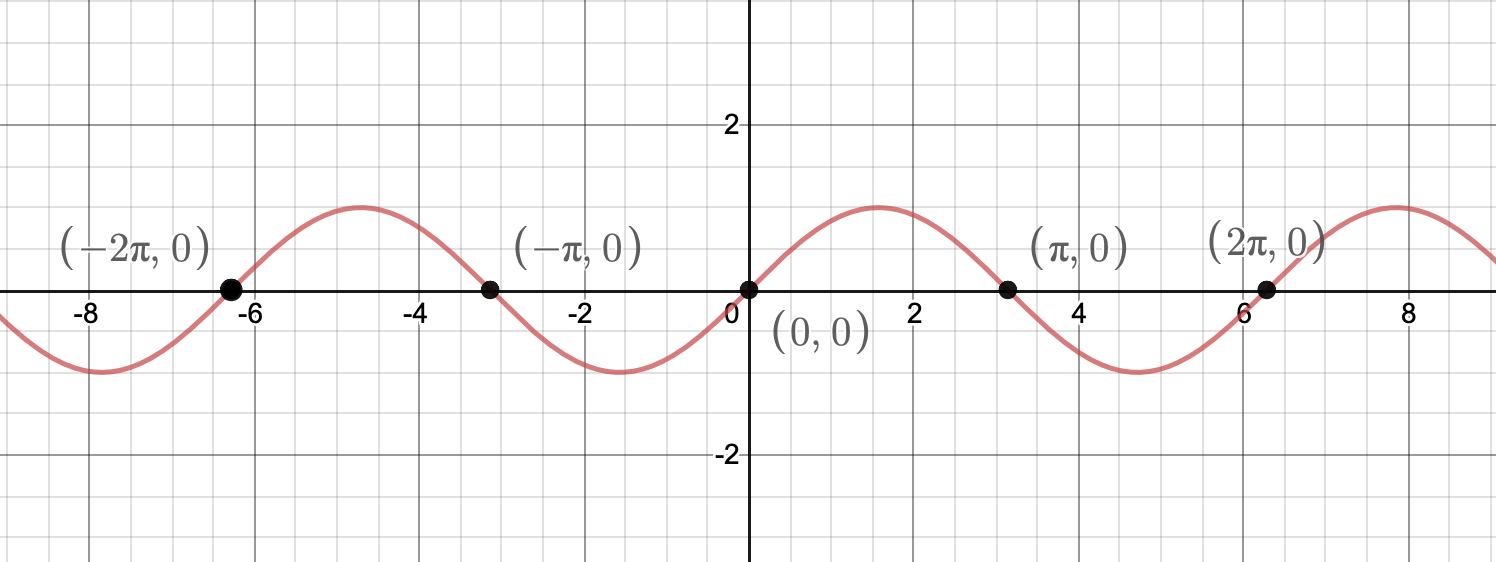
(graph of $y=\sin x$ with x between $-2\pi$ and $2\pi$)
$\bigstar$ Graph of $y=\cos x$
By the Warmup Question 2, $\cos x =0$ between $-3\pi$ and $3\pi$ when $-5\pi/2$, $-3\pi/2$, $-\pi/2$, $\pi/2$,$3\pi/2$,$5\pi/2$. On the graph below you will see the following $x$-intercepts:
$$(-5\pi/2,0), (-3\pi/2,0),(-\pi/2,0), (\pi/2,0),(3\pi/2,0),(5\pi/2,0).$$
Also, $\cos 0 = 1$, so $(0,1)$ is the $y$-intercept.
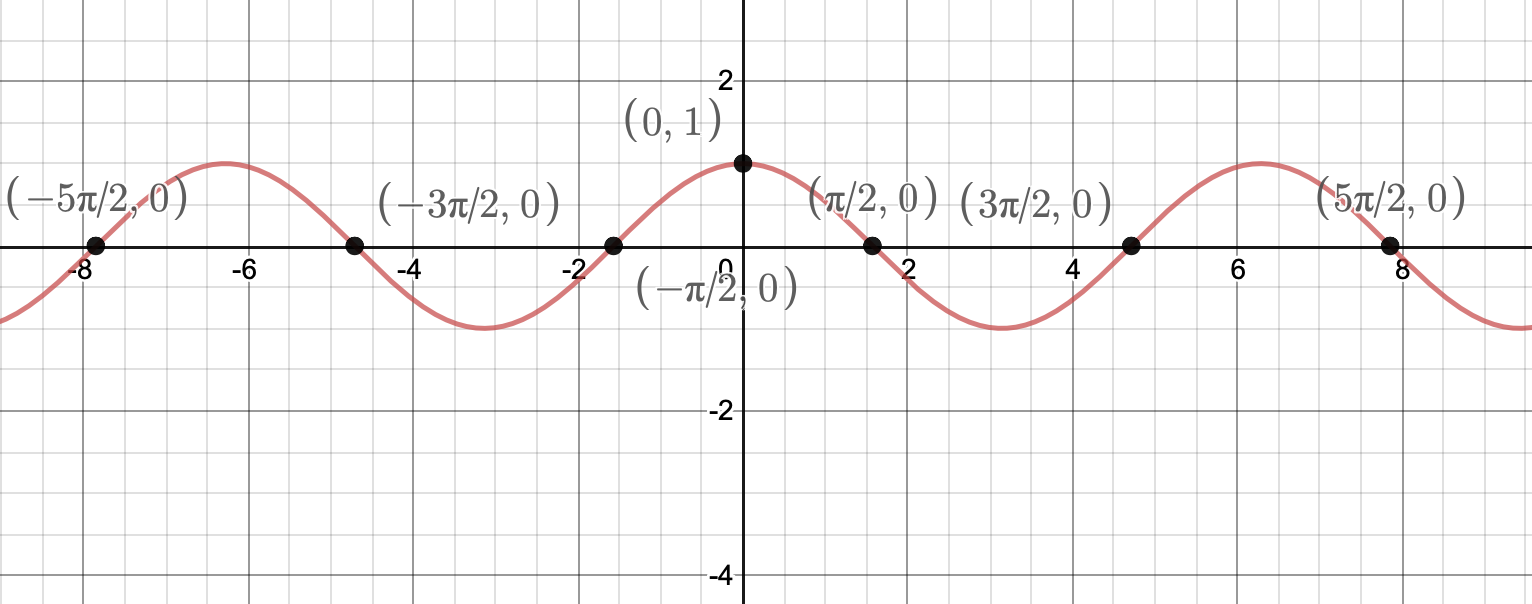
(graph of $y=\cos x$ with $x$ between $-5\pi/2$ and $5\pi/2$)
$\bigstar$ Graph of $y= \tan x$
Since $\tan x = \dfrac{\sin x}{\cos x}$, $\tan x=0$ when $\sin x = 0$. When $\cos x =0$, $\tan x$ is not defined.
By the Warmup Question 3, $\tan x =0$ or $\sin x = 0$ between $-2\pi$ and $2\pi$ when $-2\pi$, $-\pi$, $0$, $\pi$, and $2\pi$. On the graph below you see the following $x$-intercepts:
$$(-2\pi,0), (-\pi,0),(0,0),(\pi,0),(2\pi,0).$$
Also, $\tan 0 = 0$, so $(0,0)$ is both an $x$- and $y$-intercept.
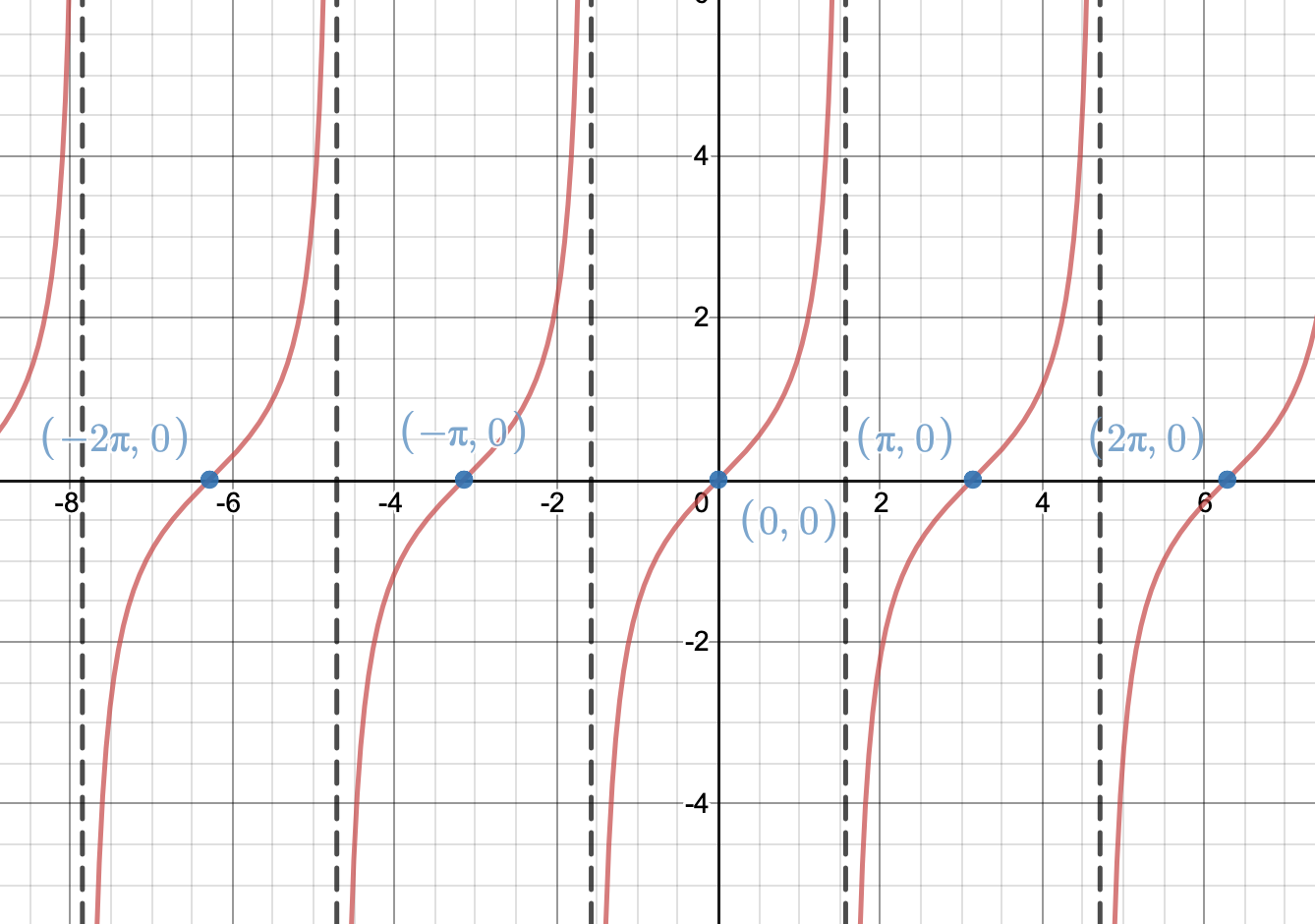
(graph of $y=\tan x$ with $x$ between $-2\pi$ and $2\pi$)
$\bigstar$ In general, for
$$y=a\sin(bx+c)\qquad\text{ or }\qquad y = a\cos(bx+c),$$
the graph is a shift/stretch/compression of the graphs of $\sin x$ and $\cos x$, respectively. The number $|a|$ is the amplitude, the number $|2\pi/b|$ is the period, and the number $-c/b$ is the phase shift.
Both $\sin x$ and $\cos x$ have amplitude 1 and period $2\pi$. This means that their values repeat every $2\pi$.
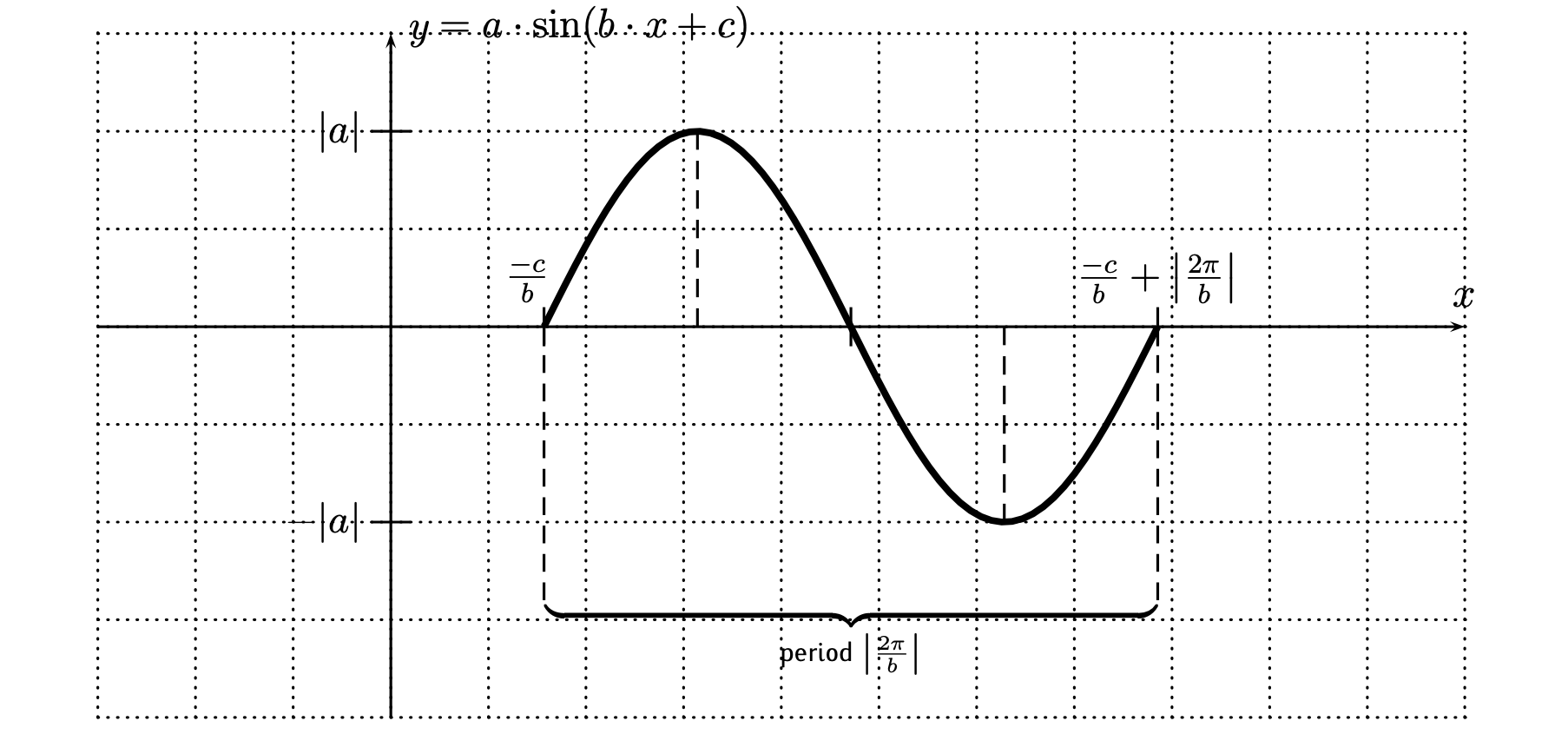
(picture taken from Precalculus by Thomas Tradler and Holly Carley)
(graph of $y=a\sin(bx+c)$ with $x$ between $-c/b$ and $-c/b+|2\pi/b|$)
Video Lesson
Many times the mini-lesson will not be enough for you to start working on the problems. You need to see someone explaining the material to you. In the video you will find a variety of examples, solved step-by-step – starting from a simple one to a more complex one. Feel free to play them as many times as you need. Pause, rewind, replay, stop… follow your pace!
Video Lesson
A description of the video resources
In the video you will see the graphs of
- $\sin x$
- $\cos x$
- $\tan x$
- $\sin(\pi x)$
- $7\cos(2x)$
- $y=-5\sin\left(\dfrac{\pi x}{2}\right)$ (here the graph is given, and the function is derived)
Try Questions
Now that you have read the material and watched the video, it is your turn to put in practice what you have learned. We encourage you to try the Try Questions on your own. When you are done, click on the “Show answer” tab to see if you got the correct answer.
Try Question 1
State the amplitude and period. Then sketch the graph through two complete cycles. Mark the $x$- and $y$-intercepts with their coordinates.
$$ y=3\sin (2x)$$
Show Answer 1
The amplitude is 3. The period is $\pi$. The $y$-intercept is $(0,0)$. The $x$-intercepts are: $(0,0)$, $(\pi/2,0)$, $(\pi,0)$, $(3\pi/2,0)$, and $(2\pi,0)$.
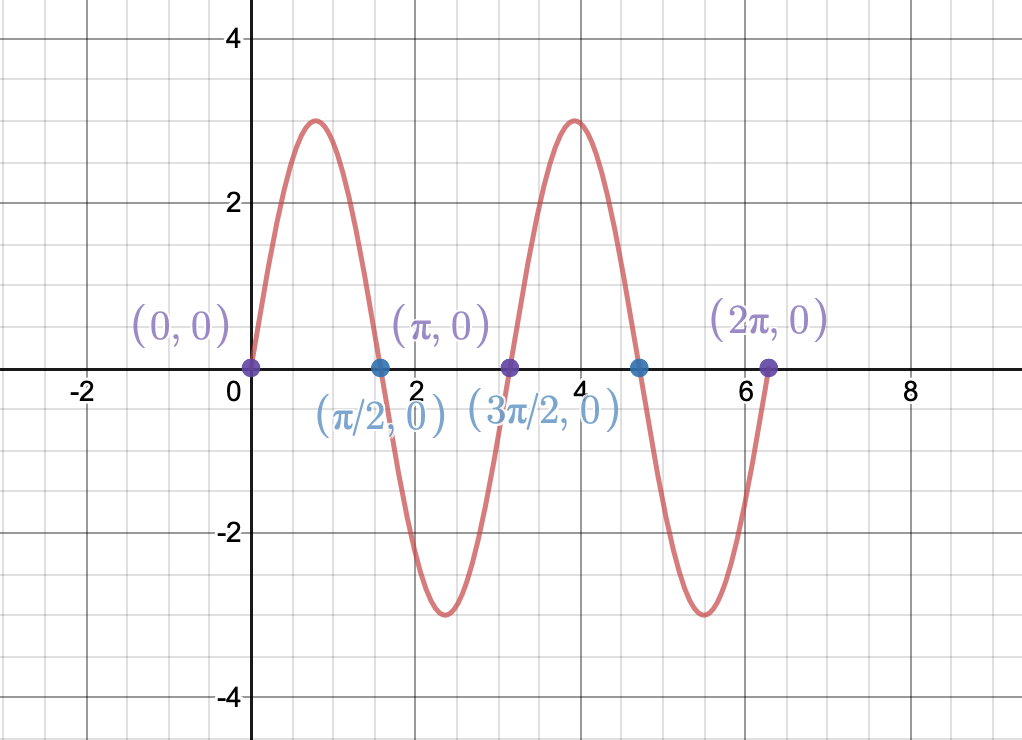
(graph of $y=3\sin(2x)$ with $x$ between $0$ and $2\pi$)
Homework
You should now be ready to start working on the homework problems. Doing the homework is an essential part of learning. It will help you practice the lesson and reinforce your knowledge.
WeBWork
It is time to do the homework on WeBWork:
GraphingSineCosine
When you are done, come back to this page for the Exit Questions.
Exit Questions
After doing the WeBWorK problems, come back to this page. The Exit Questions include vocabulary checking and conceptual questions. Knowing the vocabulary accurately is important for us to communicate. You will also find one last problem. All these questions will give you an idea as to whether or not you have mastered the material. Remember: the “Show Answer” tab is there for you to check your work!
Exit Questions
- How can we look at a graph of sine or cosine and determine its period?
- Why is it convenient to graph by dividing up a segment of the $x$-axis into 4 pieces (instead of 5 or 3, say)?
- How can we see that $\cos(x)=3$ has no solutions?
$\bigstar$ State the amplitude and period. Then sketch the graph through two complete cycles. Mark the $x$- and $y$-intercepts with their coordinates.
$$y = -2\cos (4x)$$
Show Answer
The amplitude is 2. The period is $\pi/2$. The $y$-intercept is $(0,-2)$. The $x$-intercepts are: $(\pi/8,0)$, $(3\pi/8,0)$, $(5\pi/8,0)$, and $(7\pi/8,0)$.
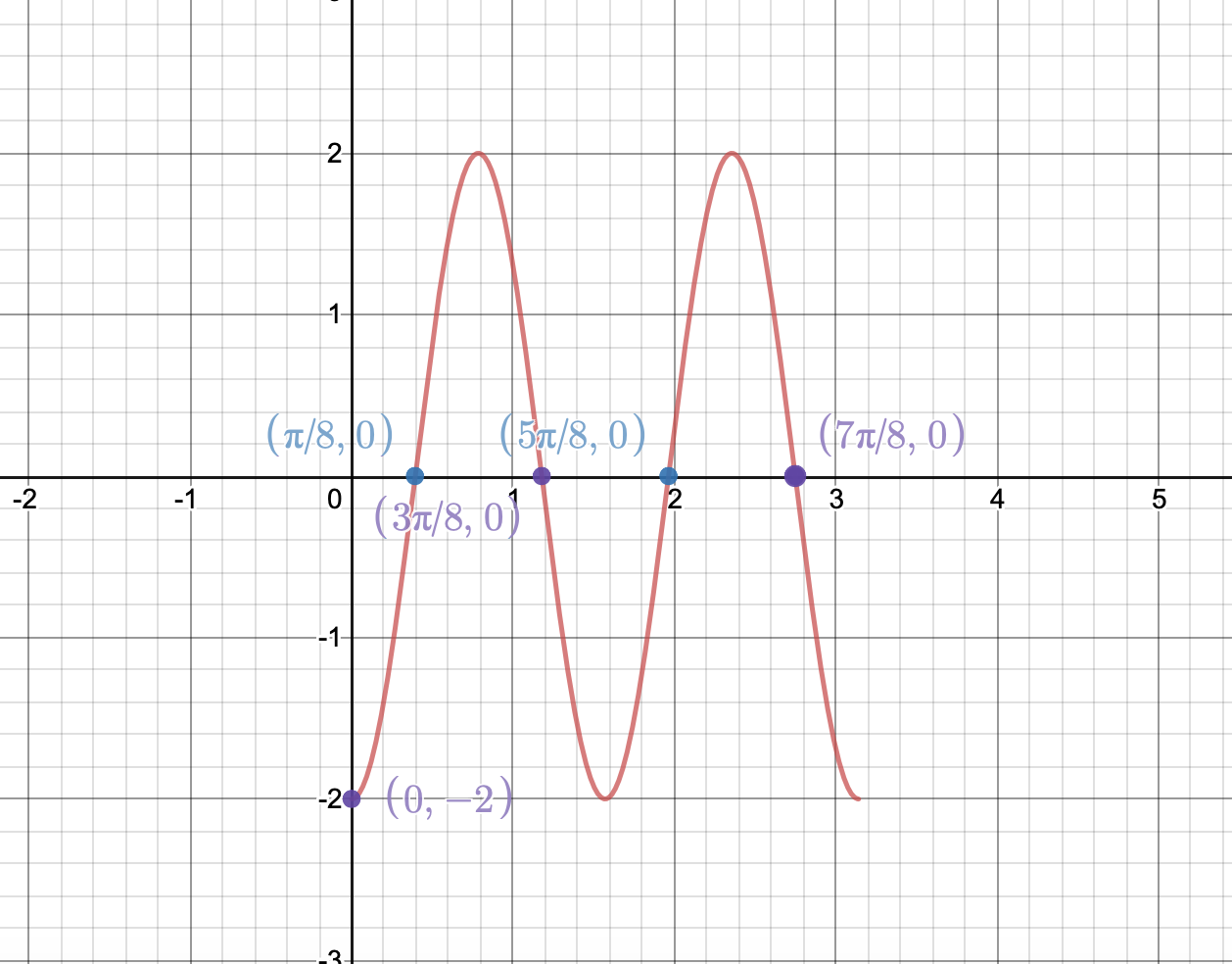
(graph of $y=-2\cos(4x)$ with x between $0$ and $\pi$)
Need more help?
Don’t wait too long to do the following.
- Watch the additional video resources.
- Talk to your instructor.
- Form a study group.
- Visit a tutor. For more information, check the tutoring page.


